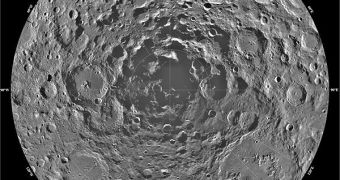The Moon is now known to have large amounts of water ice hidden in permanently shadowed craters at its South Pole. As soon as this was discovered, through an experiment conducted in 2009, scientists have begun analyzing how to use these resources to further our space exploration goals.
Three years ago, the NASA Lunar Reconnaissance Orbiter (LRO) took off from Space Launch Complex 41 (SLC-41) at the Cape Canaveral Air Force Station (CCAFS). Joining it on the Atlas V delivery system was the Lunar Crater Observation and Sensing Satellite (LCROSS).
The latter was an impactor that carried a spent Centaurus upper stage with it, for the purpose of dropping it on the surface of the Moon from orbit. When the impact occurred, a large plume of matter was ejected from the lunar surface, and analyses of the dust revealed the existence of water ice.
It was then determined that the South Pole of the Moon is a very special place. Water reserves stored in craters at this location could be used for creating rocket fuel, breathable air, and drinking water.
According to Lunar and Planetary Institute (LPI) senior staff scientist Paul Spudis, the Miniature Radio Frequency (Mini-RF) instrument on the LRO estimates that the lunar North Pole alone contains some 600 million metric tons of water stored as ice.
“If you convert that to liquid hydrogen and liquid oxygen to launch a rocket […] that is the equivalent of a space shuttle launch every day for 2,200 years. And that’s just what we can see. I think the actual amount is at least an order of magnitude greater than that,” he explains.
“So there’s plenty of water. The water is there. We can use it to actually bootstrap spacefaring infrastructure. That’s the real significance,” the expert adds. A permanent, reusable and extensible space transportation system can therefore be created on the Moon.
At this point, experts want to learn more about polar ice, lunar surface roughness and other properties of the Moon. Once this objective is reached, they will be able to devise a plan on how to best take advantage of what Earth's natural satellite has to offer.
The lunar surface may be used as a pit stop for spacecraft headed elsewhere in the solar system. If that is made possible, then vehicles would only need to carry the fuel required for them to get to space, meaning a lower launch weight.
At the same time, spent rocket stages could be refueled, therefore providing either increased range or increased speed for outgoing spacecraft, Space reports.

 14 DAY TRIAL //
14 DAY TRIAL //